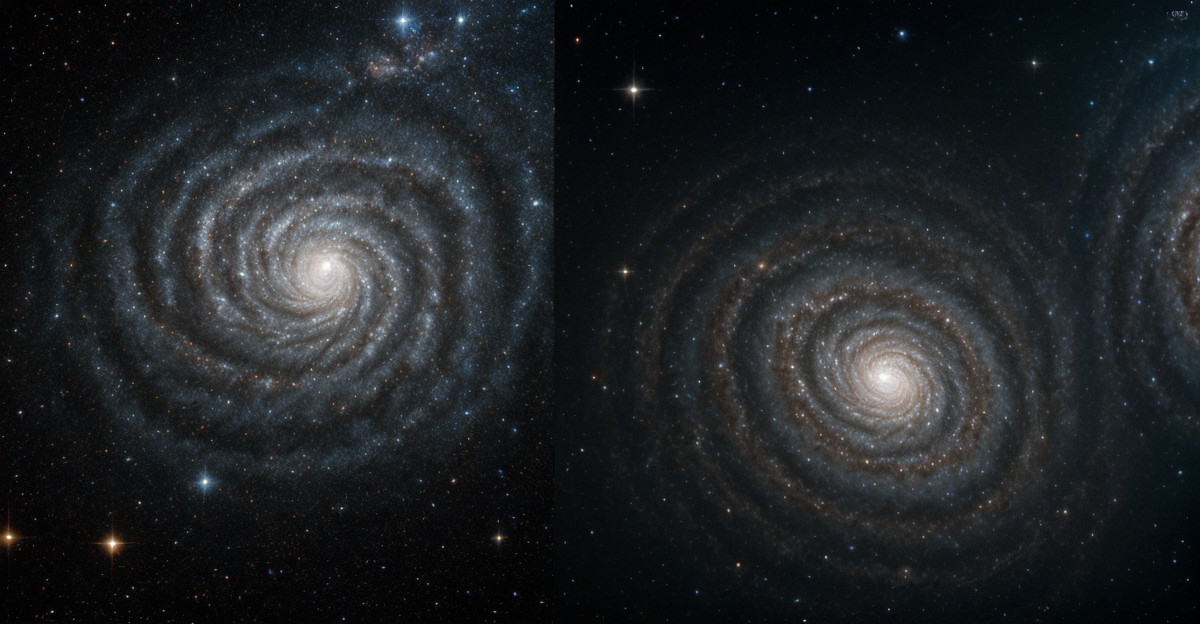
Supervoids: Immense, seemingly empty regions in the universe. Are they cosmic recycling bins hinderi
Let’s plunge into the enigmatic realm of supervoids – the seemingly desolate regions that might just be the universe’s most intriguing secrets. Forget the drama of black holes for a moment; the sheer *lack* of matter in these voids is where the real cosmic intrigue begins. ### Defining and Discovering Supervoids So, what exactly *is* a supervoid? Picture a region of space with a dramatically lower density of galaxies compared to the cosmic norm. We’re talking about areas where you’d expect to find a bustling metropolis of galaxies, but instead, you encounter… well, almost nothing. The key criterion? The number of galaxies per unit of volume must be significantly below the statistical average. The emptier, the better – or, more accurately, the *voidier*! How do we actually *find* these colossal cosmic potholes? Astronomers employ several clever techniques. One is redshift surveys, which meticulously map the locations of galaxies. Large, barren patches in these maps immediately flag potential supervoid candidates. Another method involves scrutinizing the Cosmic Microwave Background (CMB), the faint afterglow of the Big Bang. Supervoids can imprint a subtle “cold spot” signature on the CMB due to a phenomenon called the Integrated Sachs-Wolfe (ISW) effect (more on this later). Gravitational lensing, where light bends as it passes around massive objects, can also unveil the presence of these voids. ### The “Cosmic Recycling Bin” Hypothesis: Matter Drain and Formation Inhibitor The dominant theory surrounding supervoids paints them as cosmic drains, constantly siphoning off matter. Their unusually low density is thought to be a direct consequence of gravitational repulsion. Imagine it like this: in the early universe, minute density fluctuations either attracted matter (leading to the birth of galaxies) or pushed it away. Supervoids are the ultimate victors in the repulsion game. They’re so severely underdense that gravity struggles to pull matter inward, effectively preventing galaxy formation. But the influence of supervoids extends beyond mere emptiness. They can also exert a profound influence on the evolution of galaxies that lie on their fringes. The tidal forces emanating from a supervoid can warp and distort the shapes of galaxies, while the scarcity of neighboring galaxies can trigger “environmental quenching,” causing star formation in galaxies on the edge to slow down or even cease entirely. It’s like being the lonely kid on the edge of the playground, watching all the others have a blast. ### The Alternative View: Supervoids as Nurseries for “Dark Matter Filaments” Now, hold on tight, because this is where things get *truly* mind-bending. What if supervoids aren’t just empty voids after all? What if they’re secretly harboring something significant? Some scientists propose that supervoids could be nurseries for dark matter filaments – vast, invisible webs of dark matter that serve as cosmic bridges connecting galaxies across the universe. The idea is that while ordinary matter is repelled from supervoids, dark matter, which interacts with gravity in a different way, might still congregate within them. These filaments would be incredibly challenging to detect directly, because, well, they’re dark. We can’t directly observe dark matter; we can only infer its presence through its gravitational effects on visible matter. This makes confirming (or refuting) this hypothesis a formidable challenge. ### The “Cold Spot” Anomaly and the Eridanus Supervoid Remember that CMB cold spot I mentioned earlier? One of the most compelling supervoids, the Eridanus Supervoid, happens to be located in the same direction as a particularly prominent cold spot in the CMB. This cold spot is both larger and colder than predicted by our current cosmological models. The prevailing explanation centers around the Integrated Sachs-Wolfe (ISW) effect. As photons from the CMB traverse a supervoid, they lose a minuscule amount of energy, causing that region to appear colder. However, the Eridanus Supervoid doesn’t seem substantial enough to fully account for the observed cold spot, which has fueled some more outlandish theories. One, admittedly less likely but far more captivating, suggestion is that the cold spot is a consequence of a collision with a parallel universe. I know, it sounds straight out of science fiction, but some physicists haven’t completely dismissed the possibility! ### Ongoing Research and Future Prospects for Understanding Supervoids The study of supervoids is a vibrant and rapidly evolving field of research. Next-generation telescopes, such as the Vera C. Rubin Observatory (currently under construction), will furnish us with unprecedented data on the distribution of galaxies, enabling us to identify and characterize supervoids with far greater precision. Computer simulations also play a vital role. By simulating the evolution of the universe, scientists can investigate how supervoids arise and how they influence the formation of galaxies within them and on their peripheries. These simulations can help us evaluate different theories and generate predictions that can be validated through observations. So, are supervoids desolate wastelands or hidden treasure troves of cosmic secrets? The answer remains elusive, but the pursuit of that answer is pushing the very boundaries of our knowledge. What do *you* think? Are these voids truly empty, or are they merely awaiting the moment to unveil their secrets? Share your thoughts in the comments below! And don’t forget to share this with your friends who appreciate a captivating cosmic enigma!
Enjoyed this? Check out our YouTube channel for video versions!
Enjoyed this? Check out our YouTube channel for video versions!



